Beneficial
humpbacked dung beetle
Family: Scarabaeidae Subfamily: Scarabaeinae Genus: Onthophagus Species: Onthophagus binodis Thunberg, 1818
none available
Total body length 10.0–15.0 mm (0.39–0.59 in). Body shape oval; may be caked in dung. Color dull black. Small to medium-sized Onthophagus, over 6 mm. Clypealclypeal:
of, or referring to, the clypeus
apexapex:
point or edge furthest from the body
of major male weakly produced and reflexedreflexed:
margin that curves upward
; minor male and female apexapex:
point or edge furthest from the body
rounded, not reflexedreflexed:
margin that curves upward
. Head lacking horns in both sexes; female and male with curved ridge at base of head. Ocular canthuscanthus:
a process extending over and sometimes dividing the eye
not completely dividing eye. Pronotumpronotum:
the dorsal surface of the thorax
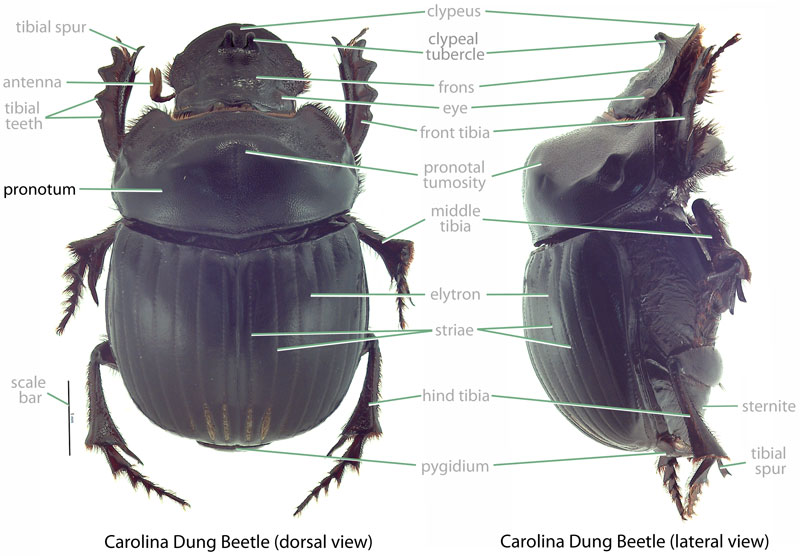 of major male with a quadratequadrate:
of major male with a quadratequadrate:
square-like in shape
, hump-like process; process reduced in minor male and female. Pronotumpronotum:
the dorsal surface of the thorax
 with anterioranterior:
with anterioranterior:
the front or forward; opposite of posterior
angles rounded in both sexes. Front tibiatibia:
a segment of the leg articulated with the tarsus and femur
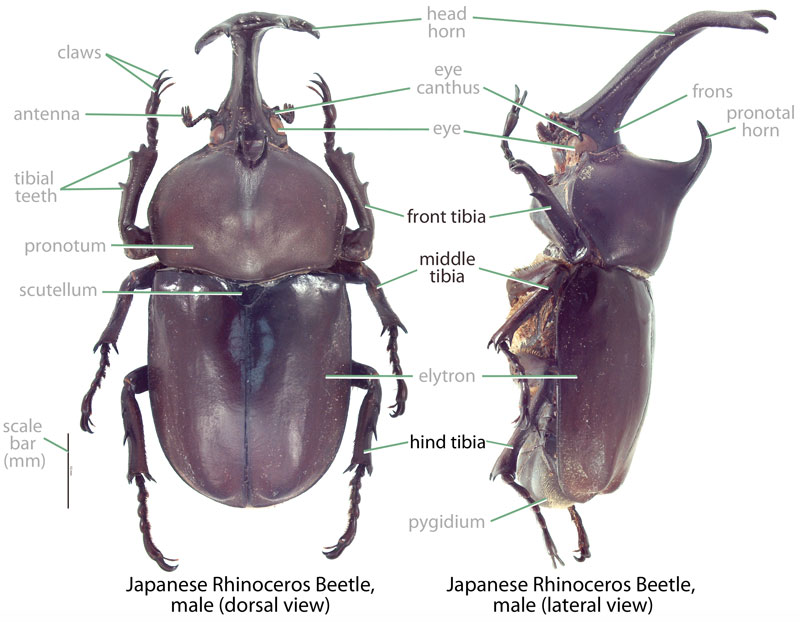 not gracilegracile:
not gracilegracile:
thin, slender, light of build
and elongate; male and female not noticeably dimorphicdimorphic:
occuring in two distinct forms
. Scutellumscutellum:
the triangular portion of the thorax between the bases of the elytra
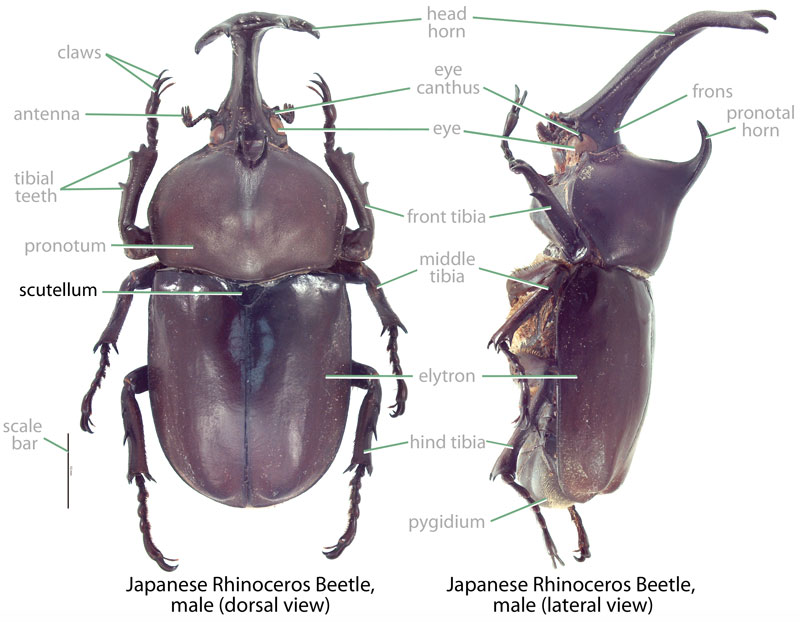 absent.
absent.
Undescribed. For Onthophagus spp. (Ritcher, 1966Ritcher, 1966:
Ritcher P. 1966. White grubs and their allies: a study of North American scarabaeoid larvae. Oregon State University Monographs, Studies in Entomology 4: 1-219.): Grub C-shaped, hump-backed, cylindrical, and cream-colored. Maxillamaxilla:
set of paired mouthparts located posterior to the mandibles
with galeagalea:
outer branch or lobe of the maxilla
 and lacinialacinia:
and lacinialacinia:
inner portion of the maxilla distinctly separate. Epipharynxepipharynx:
distinctly separate. Epipharynxepipharynx:
lobe on the interior surface of the labrum or clypeus
with tormaetormae:
in scarab larvae, sclerotized structures on the ends of the clypeolateral suture extending towards the mesal line
united mesallymesally:
at or near midline of body
, anterioranterior:
the front or forward; opposite of posterior
phoba present. AntennaeAntennae:
paired sensory organ on head, formed from numerous segments
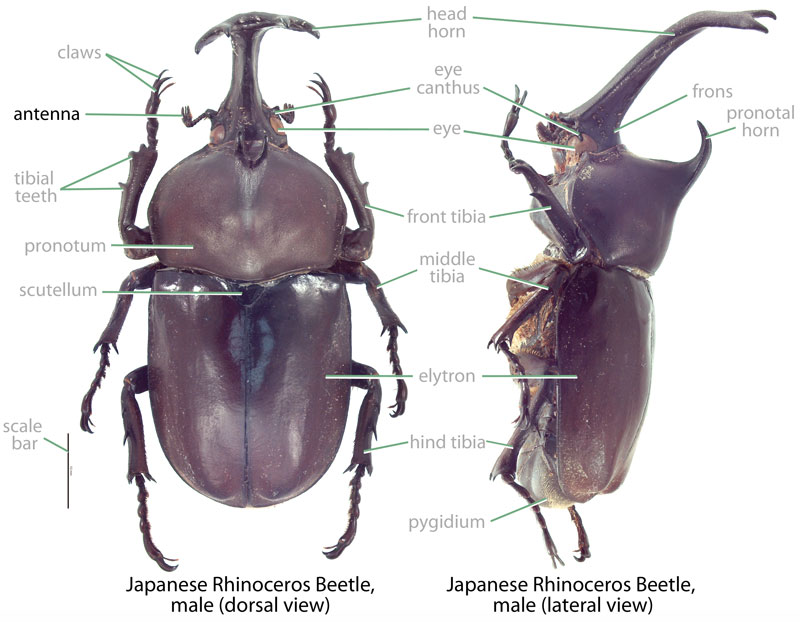 4-segmented, distaldistal:
4-segmented, distaldistal:
situated away from the point of articulation, thus usually furthest from the body
segment much reduced. Legs 2-segmented. Prothoracic shieldprothoracic shield:
the chitinous plate behind the head of larvae
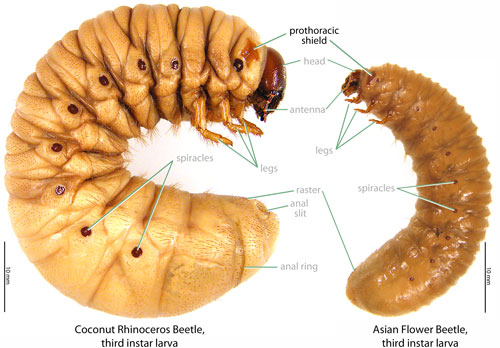 without anteriorly projecting processes. Third abdominal segment bearing a prominent conical, dorsaldorsal:
without anteriorly projecting processes. Third abdominal segment bearing a prominent conical, dorsaldorsal:
of or relating to the upper surface; opposite of ventral
gibbosity covered with numerous short, stout setaesetae:
small, hair-like structure
.
Africa. This species is known from regions of South Africa where annual rainfall exceeds 500 mm (19.7 in). It was introduced to Australia to control cattle dung and dung flies (Tyndale-Biscoe, 1990Tyndale-Biscoe, 1990:
Tyndale-Biscoe M. 1990. Common dung beetles in pastures of southeastern Australia. CSIRO Publishing, Clayton, Australia.).
None. This species feeds on dung as both an adult and larvalarva:
the immature form of an insect; in scarabs, also called grub or white grub; preceded by the egg stage, followed by the pupal stage
 . There are no records of this beetle feeding on live plant tissues.
. There are no records of this beetle feeding on live plant tissues.
This diurnaldiurnal:
active during daylight hours
species is a dung tunneler (Houston et al., 1982Houston et al., 1982:
Houston W, Feehan J, Runko S. 1982. Methods for harvesting large numbers of dung beetles (Coleoptera: Scarabaeidae). Journal of the Australian Entomological Society 21: 217–219. DOI: 10.1111/j.1440-6055.1982.tb01798.x). After locating suitable (often very wet) dung, adults construct a tunnel 3.0–17.5 cm (1.1–6.9 in) (Barkhouse and Ridsill-Smith, 1986Barkhouse and Ridsill-Smith, 1986:
Barkhouse J and Ridsdill-Smith T. 1986. Effect of soil moisture on brood ball production by Onthophagus binodis Thunberg and Euonitcellus intermedius (Reiche) (Coleoptera: Scarabaeinae). Australian Journal of Entomology 25: 75-78. DOI: 10.1111/j.1440-6055.1986.tb01076.x) beneath the fecal source in sandy soils (Tyndale-Biscoe, 1990Tyndale-Biscoe, 1990:
Tyndale-Biscoe M. 1990. Common dung beetles in pastures of southeastern Australia. CSIRO Publishing, Clayton, Australia.). LarvaeLarvae:
the immature form of an insect; in scarabs, also called grub or white grub; preceded by the egg stage, followed by the pupal stage
 are particularly sensitive to desiccation, and adults will dig deeper tunnels to avoid dry soil (Barkhouse and Ridsill-Smith, 1986Barkhouse and Ridsill-Smith, 1986:
are particularly sensitive to desiccation, and adults will dig deeper tunnels to avoid dry soil (Barkhouse and Ridsill-Smith, 1986Barkhouse and Ridsill-Smith, 1986:
Barkhouse J and Ridsdill-Smith T. 1986. Effect of soil moisture on brood ball production by Onthophagus binodis Thunberg and Euonitcellus intermedius (Reiche) (Coleoptera: Scarabaeinae). Australian Journal of Entomology 25: 75-78. DOI: 10.1111/j.1440-6055.1986.tb01076.x). Tunnels are provisioned with dung in the form of brood balls. Each brood ball is impregnated with an egg, and larval development occurs within. Development from egg to larvaelarvae:
the immature form of an insect; in scarabs, also called grub or white grub; preceded by the egg stage, followed by the pupal stage
 takes 4–6 weeks, though poor conditions will increase development time (Tyndale-Biscoe, 1990Tyndale-Biscoe, 1990:
takes 4–6 weeks, though poor conditions will increase development time (Tyndale-Biscoe, 1990Tyndale-Biscoe, 1990:
Tyndale-Biscoe M. 1990. Common dung beetles in pastures of southeastern Australia. CSIRO Publishing, Clayton, Australia.). This species is quite sensitive to low moisture environments and is rarely found in areas with prolonged dry seasons (Barkhouse and Ridsill-Smith, 1986Barkhouse and Ridsill-Smith, 1986:
Barkhouse J and Ridsdill-Smith T. 1986. Effect of soil moisture on brood ball production by Onthophagus binodis Thunberg and Euonitcellus intermedius (Reiche) (Coleoptera: Scarabaeinae). Australian Journal of Entomology 25: 75-78. DOI: 10.1111/j.1440-6055.1986.tb01076.x).
None. This species recycles dung and is beneficial for ranching and farming in Hawaii. Primarily being a dung feeder, this species has never been recorded damaging crop or ornamental plants. Additionally, this species is not a threat to native dung beetles because none occur in Hawaii or Guam.
Established. This species was introduced to Big Island in 1973 to help control populations of the horn fly (Haematobia irritans), a biting pest of livestock (Markin and Yoshioka, 1998Markin and Yoshioka, 1998:
Markin G and Yoshioka E. 1998. Biological control of the horn fly, Haematobia irritans L., in Hawai'i (Diptera: Muscidae). Proceedings of the Hawaiian Entomological Society 33: 43-50. full text (accessed 2015)). It is now established on Big Island where it occurs at higher elevations (Markin and Yoshioka, 1998Markin and Yoshioka, 1998:
Markin G and Yoshioka E. 1998. Biological control of the horn fly, Haematobia irritans L., in Hawai'i (Diptera: Muscidae). Proceedings of the Hawaiian Entomological Society 33: 43-50. full text (accessed 2015)).
Not established or recorded. This species has not been recorded from Guam.
In Hawaii, this species was intentionally imported.
This species could be confused with similarly colored small to medium-sized dung beetles (6+ mm) including Onthophagus species such as Onthophagus laminatus, Onthophagus cuniculus, Onthophagus incensus, Onthophagus armatus, and Onthophagus comperei.
Major males can be separated by examining the head armature (O. binodis lacking horns or tubercles versus O. laminatus, O. incensus, O. armatus, and O. comperei with horns versus O. cuniculus with two tubercles).
Females are separated by examining the base of the head (O. binodis with a slightly curved ridge versus O. cuniculus, O. laminatus, and O. incensuswith a transversetransverse:
extending horizontally across a surface
ridge versus O. armatus with feebly bisinuatebisinuate:
possessing two sinuate edges or portions, with two curves
ridge versus O. compereiwith 2 tubercles), pronotumpronotum:
the dorsal surface of the thorax
 (O. binodis with a lobe-like process versus O. cuniculus with a bi-lobedbi-lobed:
(O. binodis with a lobe-like process versus O. cuniculus with a bi-lobedbi-lobed:
possessed of two lobe-like structures
process versus O. incensus, O. armatus, and O. comperei without a process), and anterioranterior:
the front or forward; opposite of posterior
pronotal angle (O. binodis with anterioranterior:
the front or forward; opposite of posterior
angle rounded versus O. laminatus and O. cuniculus with angle curving outward).
Onthophagus columella Fahreus in Boheman
Report your observation of this beneficial species at our iNaturalist project.